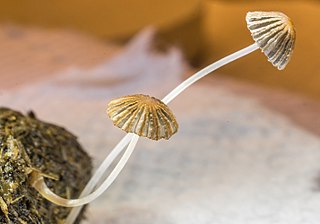
Coprophilous fungi are a type of saprobic fungi that grow on animal dung. The hardy spores of coprophilous species are unwittingly consumed by herbivores from vegetation, and are excreted along with the plant matter. The fungi then flourish in the feces, before releasing their spores to the surrounding area.
Coprinellus curtus is a species of mushroom in the family Psathyrellaceae. It was first described as Coprinus curtus by Károly Kalchbrenner in 1876 before being transferred to the genus Coprinellus in 2001.
Tulosesus heterosetulosus is a species of mushroom producing fungus in the family Psathyrellaceae.
Coprinellus heptemerus is a species of mushroom in the family Psathyrellaceae. It was first described as Coprinus heptemerus by mycologists M. Lange and Alexander H. Smith in 1952, and later transferred to the genus Coprinellus in 2001. It is a coprophilous fungus and it is known to occur on the dung of goats and possibly on that of sheep.

Coprinopsis radiata, formerly known as Coprinus radiatus, and commonly known as the miniature woolly inky cap, is a coprophilous fungus that grows on herbivore dung. It is heterothallic.
Triangularia setosa is a member of the Ascomycota, and of the genus Triangularia. This genus is notable for its widespread appearance on the excrement of herbivores, and is therefore seen as a coprophilous fungus. The fungus itself is characteristically dark in colour and produces sac-like perithecium with a covering of hair. Its dispersion involves the ingestion, passage, and projectile ejection of spores. It has preference for colonizing the dung of lagomorphs, such as hares and rabbits.
Ascobolus immersus is a species of fungus belonging to the family Ascobolaceae.
Ascobolus brantophilus is a species of coprophilous fungus in the family Ascobolaceae. It grows on goose droppings.
Lasiobolus lasioboloides is a species of coprophilous fungus in the family Ascodesmidaceae. It grows on the dung of sheep.
Lasiobolus cuniculi is a species of coprophilous fungus in the family Ascodesmidaceae. It is known to grow on the dung of sheep, goats and donkeys.
Podospora decipiens is a species of coprophilous fungus in the family Podosporaceae. It is especially common on the islands around Greece, where it grows on the dung of sheep, goats and donkeys.
Podospora macrodecipiens is a species of coprophilous fungus in the family Podosporaceae. It was discovered in Antiparos in Greece, where it was found growing on sheep dung.
Podospora pleiospora is a species of coprophilous fungus in the family Podosporaceae. It is especially common on the islands around Greece, where it grows on the dung of goats and sheep.
Schizothecium inaequale is a species of coprophilous fungus in the family Lasiosphaeriaceae. It is known to grow in the dung of goats.
Schizothecium miniglutinans is a species of coprophilous fungus in the family Lasiosphaeriaceae. It is known to grow in the dung of goats and possibly on that of sheep.
Schizothecium tetrasporum is a species of coprophilous fungus in the family Lasiosphaeriaceae. It is known to grow in the dung of goats and rabbits.
Coprinopsis pseudoradiata is a species of coprophilous fungus in the family Psathyrellaceae. It grows on the dung of sheep.

Coprinopsis stercorea is a species of coprophilous fungus in the family Psathyrellaceae. It grows on the dung of sheep, goats and donkeys.
Coprinopsis vermiculifer is a species of coprophilous fungus in the family Psathyrellaceae. It is known to grow on the dung of goats.

Parasola misera is a species of coprophilous fungus in the family Psathyrellaceae. It grows on the dung of goats and possibly on that of sheep.



